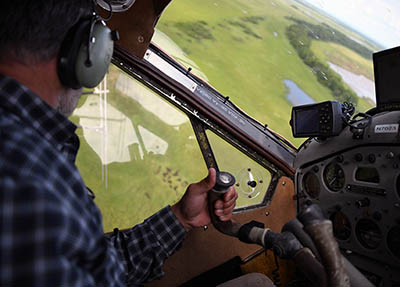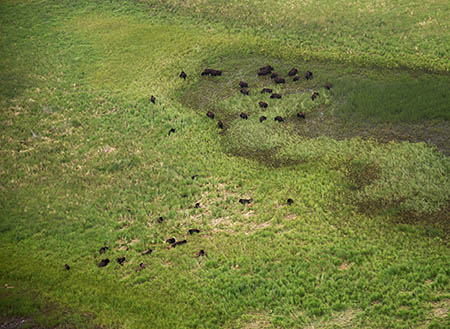Alaska Fish & Wildlife News
November 2020
Wood Bison Adapting in 2020
Wood Bison update 2020

Alaska’s herd of wild wood bison has seen some ups and downs over the past five years. The spring 2020 survey resulted in a population estimate of 94 bison including nine calves. This is a 17 percent decrease from last year’s estimate of 113.
The winter of 2019-2020 was difficult, with deep snow and cold temperatures. The wood bison fared well for most of the winter, but deep snow that persisted through most of April took a toll. Snow conditions, specifically in April, seem to regulate the growth of this population. If there is deep, ice layered snow through April in the grass meadows, the bison tend to decline. If there are open grass meadows from most of April, the bison herd increases.
This experimental population was placed in the lower Innoko-Yukon area to begin restoring a native species to Alaska in a place with vast grassland habitats and abundant support from local people. Wood bison lived in Yukon Flats and other areas of Alaska from about 10,000 years ago until they disappeared more than 100 years ago. In 2015, after two decades of preparation, 130 wood bison were reintroduced to Alaska. It was known from the start that the occasional, notorious late winter snows of the area could negatively impact the bison, but it was unknown to what degree.

As bad as the spring snow conditions were in 2020, the bison did better than expected. They seem to be adapting to the harsh, late winter snow conditions that they experienced in both 2018 and 2020. Since their release in 2015, these bison have experienced three years of growth and two years of decline. What is notable this year is that the decline was less dramatic than the one in 2018.

Bison are generalist herbivores and adapt well to varied habitats. Bison have a strong social structure and the young stay with the adult females for at least three years. Female bison often stay with their mother for life. Bison social structure has developed, in part, so that young bison can learn all the nuances of the way the older bison have adapted to succeed in their specific habitat. In this way, the herd adapts its behavior and gets better at surviving in their new home each year.
If you can imagine the release in 2015, none of the bison knew where the best forage and cover were. None of them knew what or where the hazards were going to be, like thin ice, predators, and soft mud. In the five years since release, these bison have learned where the best forage is, what the hazards are and how to avoid them. They have experienced difficulties like the April deep snows - each year these bison experience challenges, and they learn how to survive and succeed when that challenge comes their way the next time. This demonstrates the notion of survival and growth through adversity.

At this point, the first wild wood bison population in Alaska in more than 100 years has become established and is holding its own, despite facing extremely adverse weather during multiple winters following initial establishment of the herd. With continued adaptation and weather patterns resulting in less late winter snow, this population will continue to learn and grow in the future.
Wood bison species profile offers more resources on the wood bison herd.
Subscribe to be notified about new issues
Receive a monthly notice about new issues and articles.
